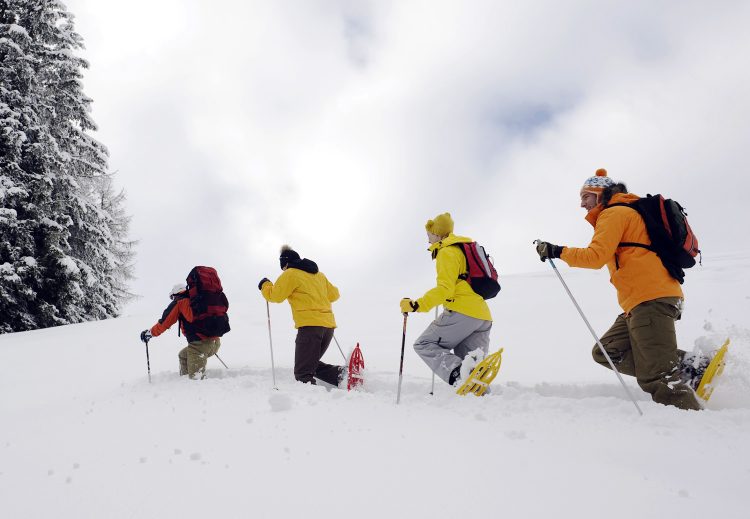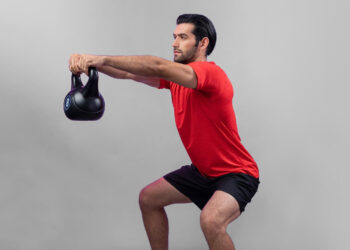How many calories do you burn Snowshoeing for an hour?
The average person burn 455-857 calories in 60 minutes Snowshoeing (for a 180lb person), depending on the effort put.
If you want an exercise that is fun but will still help you burn plenty of calories, then this popular and affordable sport is exactly what you are looking for. It’s the type of sport that you can do alone or bring the whole family.
Snowshoeing is more of a casual sport without the adrenaline rush of skiing or snowboarding. There are also so many health benefits that come with snowshoeing, such as:
- Low-impact muscle building
- Balance agility and strengthening
- Fantastic cardiovascular workout
- Builds endurance
The number of calories that you burn will depend on several factors, including your height, weight, and amount of time spent snowshoeing.
How To Use the Calculator
Using the snowshoeing calculator is very simple. To calculate how many calories you are burning from snowshoeing, just input your weight and the time you’ve spent or plan to be on snowshoes. Then simply select the type of activity you plan to perform and then hit CALCULATE. It’s that easy!
Using the calculator step-by-step:
Level Up Your Fitness: Join our 💪 strong community in Fitness Volt Newsletter. Get daily inspiration, expert-backed workouts, nutrition tips, the latest in strength sports, and the support you need to reach your goals. Subscribe for free!
- Choose your unit of measurement (pounds or kilograms)
- Enter your weight and select the amount of time that you’re snowshoeing for
- There are two types of snowshoeing activities that you can choose from. These are going to be moderate effort or vigorous effort. It really depends on how much effort you want to put into your activity.
- Hit CALCULATE
How the Calculator Works
Our snowshoeing calorie calculator uses MET (metabolic equivalent of task) values to determine the number of calories that snowshoeing will burn. This value is determined as set by a convention of 3.5 mL of oxygen per kilogram of body weight each minute while snowshoeing [1].
MET (Metabolic Equivalent of Task)
Using MET to find out your body’s energy expenditure is what our snowshoeing calorie calculator is used for. The MET value is the number that determines the energy that it takes to perform various activities, such as vigorous snowshoeing activity [3]. This ratio shows the relationship between your active metabolic rate and your resting metabolic rate.
The active metabolic rate (AMR) determines the calories that you continue to burn throughout the day. In contrast, the resting metabolic rate (RMR) measures the number of calories that you are burning when your body is at rest and not actively digesting.
Activities that have a MET value of 1 will burn as many calories as your RMR, while activities with a MET of 4 will burn four times as many calories as your RMR. This means that you expend 4 times as much energy as the activity with only 1 MET.
Formula
The formula that our shoveling snow calorie calculator uses to determine the number of calories burned per minute is (MET x bodyweight in Kg x 3.5) ÷ 200.
Examples
An individual weighing 180 pounds will burn approximately 454 calories every hour while snowshoeing. Snowshoeing with moderate effort has a MET of 5.3, which means that it burns 3.5 times as many calories as your RMR.
This is what the formula for calculating the calories burned while snowshoeing with moderate effort will look like:
- Calories burned (per minute) = (body weight in kg x MET x 5) ÷ 200
- Calories burned (per minute) = (81.65 x 3 x 3.5 ) ÷ 200
- Calories burned (per minute) = 57 calories x 60
- Calories burned (per hour) = 454 calories per hour
Snowshoeing with vigorous effort will yield different results. People who snowshoe with vigorous effort will burn more calories than if users were snowshoeing with moderate effort. An example of what a vigorous effort snowshoeing looks like for a 180-pound person is below:
- Calories burned (per minute) = (body weight in kg x MET x 5) ÷ 200
- Calories burned (per minute) = (81.65 x 10 x 5 ) ÷ 200
- Calories burned (per minute) = 28 calories x 60
- Calories burned (per hour) = 856 calories per hour
What is Snowshoeing?
People have been snowshoeing for over 6,000 years, and it’s become a popular sport because it’s a low-impact sport, which means that anyone can do it, and it burns a lot of calories.
It never used to be considered just a sport, it started off as a means of transportation across paths of snow.

Highly Accessible
All ages can partake in snowshoeing because it’s low impact. It doesn’t matter your strength level, body type or age, you can take part in any snowshoeing activity. For years, pregnant women and seniors have taken part in this sport for their health because there are so many benefits to it.
History of Snowshoeing
Snowshoeing came about in Central Asia some 6,000 years ago. Ancestors migrated to North America and brought the practice of snowshoeing with them.
At the time, snowshoes were nothing more than slabs of wood. However, they soon evolved into white ash-framed snowshoes with rawhide lacing, which is similar to what snowshoes are like today.
Before the 70s, snowshoes were used for survival or as a means of getting to employment in snowy parts. At the time, there were three different styles of snowshoes. The long Yukon snowshoe was created for moving through deep, powder-covered open areas.
Level Up Your Fitness: Join our 💪 strong community in Fitness Volt Newsletter. Get daily inspiration, expert-backed workouts, nutrition tips, the latest in strength sports, and the support you need to reach your goals. Subscribe for free!
The ova-shaped bear paw was created for use in areas that were mostly forested where maneuverability was key. Finally, the beavertail snowshoe took advantage of both features and was utilized for all types of snow conditions.
Health Benefits of Snowshoeing
Snowshoeing can be a lot of fun once you get the hang of it. It’s easy to get hooked on this exercise, especially when you realize all the health benefits involved.
Burning Calories
We’ve already touched base on the calorie-burning that snowshoeing does for you. It’s considered to be an intense cardiovascular exercise. On average, you can burn upwards of 600 calories, which is 45% more calories burned than an hour of regular walking.
Any type of physical activity is sure to get your heart pumping faster. When the heart starts pumping, blood will be sent to the lungs and muscles. That makes it possible to breathe better and get more oxygen. Oxygen is supplied to the brain and muscular cells, which means that you have an ability to think clearer, have less of a scattered brain, and you just feel better overall.
You Instantly Feel Good
Snowshoeing makes you feel good. Being out in the winter sun actually increases the serotonin levels in your body [4]. So you will instantly feel calmer after spending an hour out in the sun breathing in that fresh air.
Decreases Muscle Soreness
You wouldn’t think that exercise can decrease soreness in your body, but it’s very true. When your muscles get more oxygen, they can achieve more [2]. The sweat that comes out of the exertion of your exercise will flush out the toxins in your body, which helps to decrease the stiffness and soreness in your body.
Your head will feel clear, and your body will start feeling lighter and warmer. By being outside in the sun, you also get your daily exposure of Vitamin D.
Helps Fight the Winter Blues
Some people experience depression throughout the winter, called the winter blues. It occurs when people tend to spend more time indoors because of the weather. This can cause more stress and depression over those winter months.
Snowshoeing not only has physical benefits but mental and emotional as well. By being out in the fresh air, taking a casual stroll through snow-covered paths, you are getting fresh air and allowing yourself to see areas that are truly beautiful. In addition, it allows you some time to reflect on your life, and you can feel all the negative energy leaving your body with every step.
Stress Reducer
In addition to its physical benefits, snowshoeing gives you an opportunity to socialize with other people. While you are out on the paths, you are likely to find other people who cross your path. You can also take the opportunity to make the day a family affair. Social bonding will help you to forget your problems for the time being which will reduce the stress in your life.
Helps You To Lose Weight
If you are looking to lose weight, then forget those fad diets and extreme workouts. Instead, you can take on a sport like snowshoeing and know that it’s going to help you to achieve the results that you want. If you love the outdoors, then this is a great exercise that will help you achieve your goals.
As you find a routine for snowshoeing in your life, you will start to build muscle and burn fat through the exercise that snowshoeing involves. This makes it a great way to burn calories and lose weight.
Frequently Asked Questions:
What muscles do you use when snowshoeing?
Typically, snowshoeing is a lower body workout that focuses on the quads, hamstrings and calf muscles. You can snowshoe anywhere that has snow, whether that’s trails or urban settings. If you want to get an upper body workout as well, you can add hiking poles that will target your shoulders and back.
Can you lose weight by snowshoeing?
Snowshoeing can help you achieve your goals of losing weight and living a healthier lifestyle. You can easily burn twice the number of calories as you would if you were just walking. In addition, you can burn upwards of 600 calories per hour which makes the fun sport of snowshoeing advantageous.
Can you work your abs while snowshoeing?
Your abdominals, as well as the back muscles on both sides, are working hard to control the trunk area while you snowshoe. This can give you an intense ab workout while snowshoeing.
Is snowshoeing good for the knees?
It’s unlikely that you would succumb to a knee injury while snowshoeing. While exercising your legs, you build muscle and build a more toned physique. Your ligaments are very supple which minimizes your chances of being injured.
Conclusion
Snowshoeing for exercise can be a great way to burn calories while also having fun with friends and family. It’s also a great way to be alone and spend some time reflecting peacefully. Using the snowshoeing activity calorie calculator will give you a realistic idea of how many calories you can expect to burn while snowshoeing.
There are many places that you can snowshoe including large parks or cross-country skiing areas. If you want to get really adventurous with your sport you can look up the amazing snowshoe places located in places like Iceland, the French Alps or Austria.
Generally speaking, snowshoeing is one of the safest sports that you can try. It’s an easy exercise, even for beginners and considering its low-impact, even seniors can take advantage of the exercise.
References:
- Jetté, M., Sidney, K., & Blümchen, G. (1990). Metabolic equivalents (METS) in exercise testing, exercise prescription, and evaluation of functional capacity. Clinical cardiology, 13(8), 555–565. https://doi.org/10.1002/clc.4960130809
- The energy expenditure of snowshoeing in packed vs. unpacked snow at low-level walking speeds. Connolly DA. J Strength Cond Res. 2002 Nov;16(4):606-10. PMID: 12423193
- Arizona State University Healthy Lifestyles Research Center – Compendium of Physical Activities – Winter Activities – Provides MET values for winter activities, including snowshoeing.
- Mohammad-Zadeh, L. F., Moses, L., & Gwaltney-Brant, S. M. (2008). Serotonin: a review. Journal of veterinary pharmacology and therapeutics, 31(3), 187–199. https://onlinelibrary.wiley.com


















I am 62. I snowshoe all winter.i lost 45 pounds with this activity…